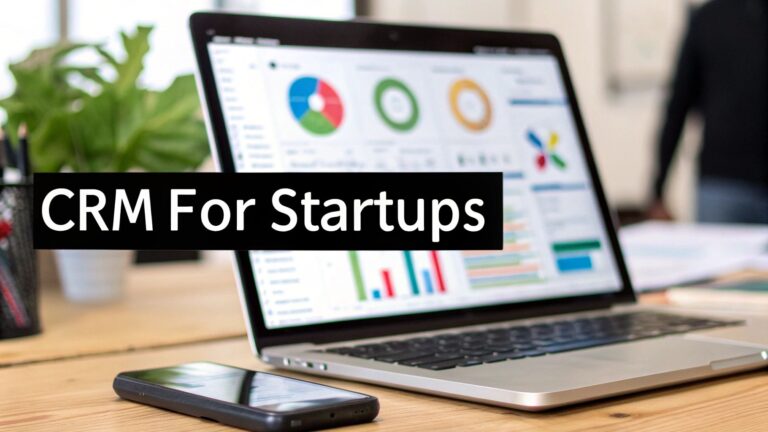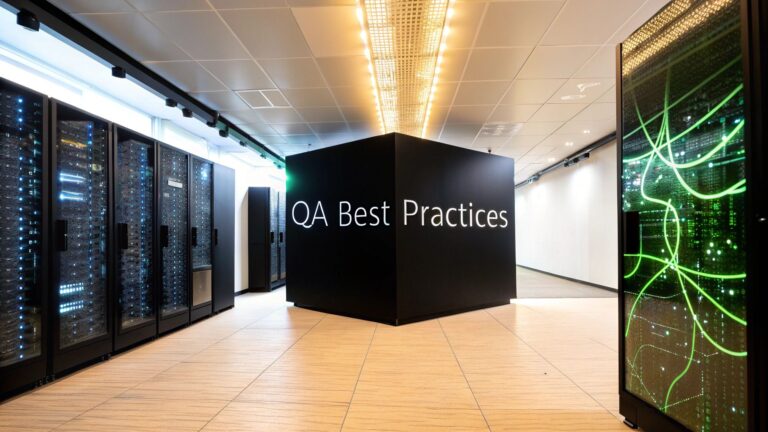Top 12 Best AI Tools for Recruitment in 2025
The traditional hiring process is time-consuming, expensive, and often riddled with unconscious bias. For busy B2B founders, HR leaders, and startup entrepreneurs, the manual slog of sourcing, screening, and scheduling candidates is a significant bottleneck to scalable growth. This is precisely the problem that modern AI recruitment platforms are built to solve. By automating repetitive tasks and providing data-driven insights, these tools empower you to build a stronger, more diverse workforce with unprecedented efficiency.
This comprehensive guide is designed to help you navigate the crowded market and identify the best AI tools for recruitment that align with your specific organizational needs. We move beyond generic marketing claims to offer a detailed analysis of 12 leading platforms. You won’t find surface-level reviews here; instead, we provide an in-depth look at each tool's core functionality, practical use cases, and honest limitations.
Inside, you will find a breakdown of each platform, including:
- Key Features & Use Cases: What the tool does best and how you can apply it.
- Pros & Cons: A balanced view of strengths and potential drawbacks.
- Implementation Tips: Practical advice to ensure a smooth rollout.
- Screenshots & Direct Links: Visualize the interface and access the platform easily.
This resource will help you cut through the noise and select a solution that genuinely enhances your talent acquisition strategy. While this list focuses on AI-centric platforms, the field of hiring technology is vast. To explore a wider range of platforms that automate hiring tasks and leverage advanced technology, delve into the best recruitment automation software solutions available today. Let’s get started.
1. HireVue
HireVue positions itself as a premium video interviewing and assessment platform, leveraging AI to streamline the early stages of the recruitment funnel. It’s one of the best AI tools for recruitment for high-volume hiring, allowing teams to move beyond traditional resume screening. The platform uses a combination of on-demand video interviews, game-based challenges, and coding assessments to evaluate candidates.
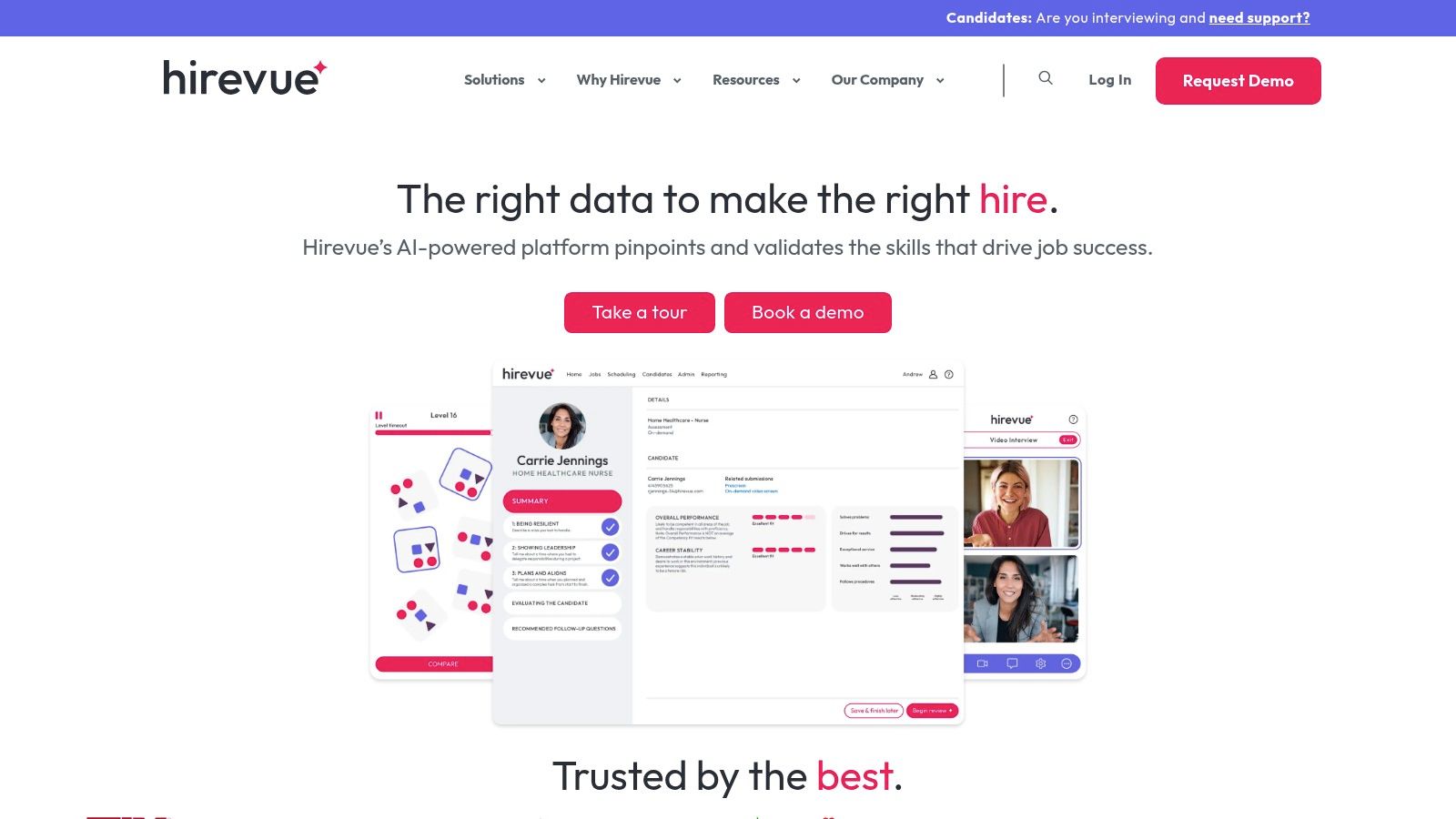
The AI analyzes candidate responses, including verbal and non-verbal cues (in specific assessment models), to generate insights and predictive performance scores. This data helps recruiters prioritize candidates who demonstrate key competencies for the role, significantly reducing the time spent on initial screenings.
Key Features & Use Cases
HireVue excels at standardizing the initial interview process, ensuring every applicant receives an identical experience. Its integration capabilities with major Applicant Tracking Systems (ATS) like Workday and SAP SuccessFactors make it a seamless addition to existing HR tech stacks.
- Use Case: A large enterprise needs to screen thousands of applicants for a global graduate program. Using HireVue, they can deploy a standardized on-demand video interview to all candidates, using AI to score and rank them based on predefined core competencies, identifying the top 10% for the next round.
- Unique Offering: The platform offers game-based assessments that measure cognitive abilities and emotional intelligence in an engaging format, providing a richer data set than a simple Q&A.
Implementation Tip: Start by using HireVue for a single, high-volume role to benchmark its effectiveness against your traditional process. Clearly define the competencies you want the AI to assess and train your hiring managers on how to interpret the AI-generated reports to avoid over-reliance on scores.
Pricing and Limitations
HireVue’s pricing is enterprise-focused and not publicly listed; it requires a custom quote based on company size and usage volume. This makes it less accessible for startups and small businesses.
| Pros | Cons |
|---|---|
| Drastically reduces time-to-hire | High cost, built for mid-to-large enterprises |
| Provides detailed analytics and insights | Potential for AI bias if not properly configured and monitored |
| Enhances candidate experience with flexibility | Steep learning curve for full platform utilization |
While powerful, teams must be aware of and actively mitigate potential AI bias. It is crucial to regularly audit the algorithm's performance and ensure it aligns with diversity and inclusion goals.
Website: https://www.hirevue.com
2. Paradox
Paradox centers its offering on Olivia, a conversational AI assistant designed to automate and personalize high-volume recruiting tasks. As one of the best AI tools for recruitment, it focuses on engagement, handling initial candidate interactions via text, web chat, and social media. Olivia can screen applicants, answer their questions 24/7, and schedule interviews directly onto recruiters' calendars, freeing them from administrative burdens.
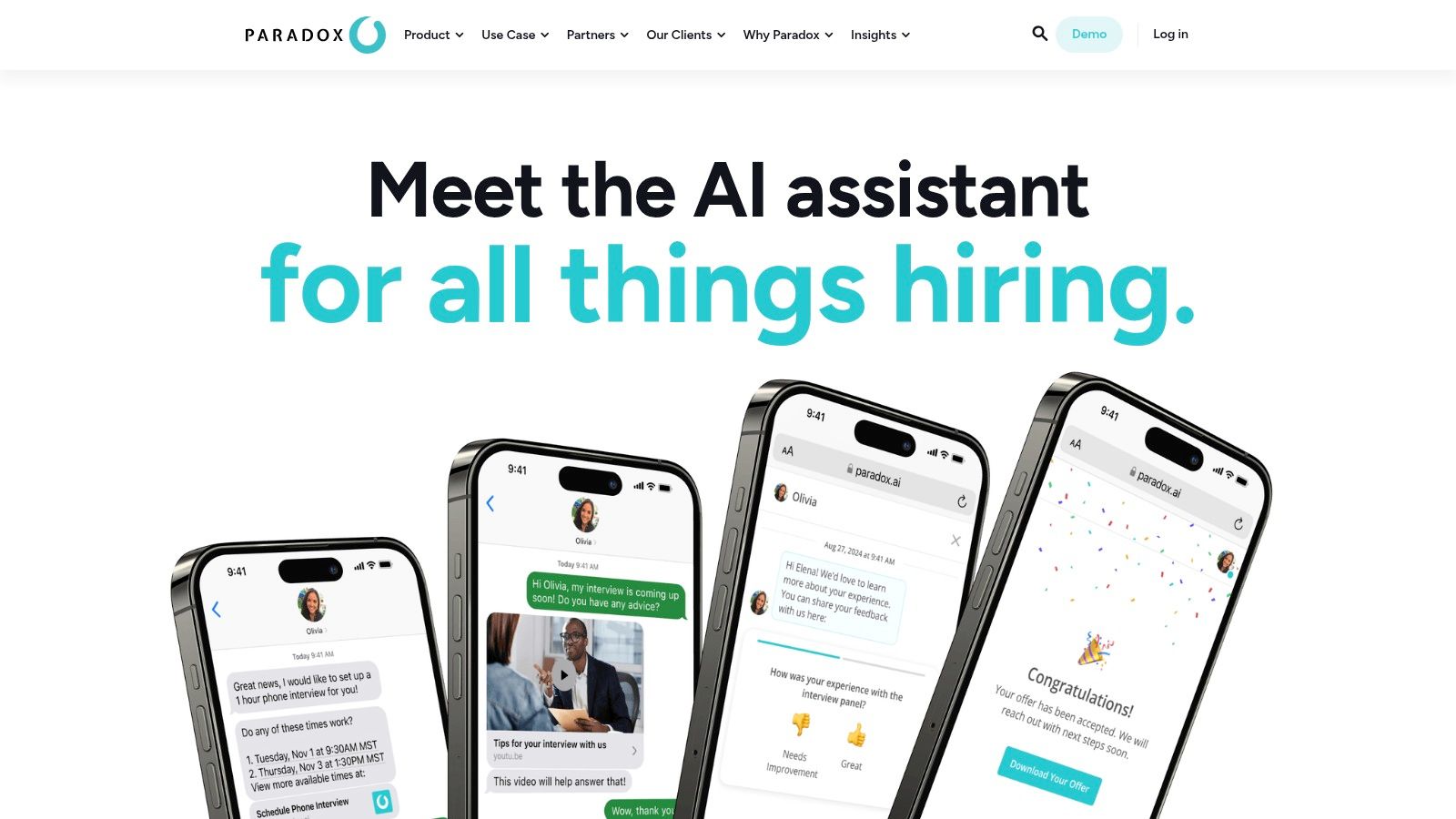
The platform’s core strength is its ability to create a fast, seamless, and mobile-first application experience. By automating the top-of-funnel logistics, Paradox helps recruitment teams drastically reduce time-to-hire and improve overall productivity, ensuring no qualified candidate is lost due to slow response times.
Key Features & Use Cases
Paradox excels at creating a consumer-grade candidate experience, making the application process as easy as ordering a pizza. Its powerful automation capabilities integrate directly with leading Applicant Tracking Systems (ATS), making it a valuable addition to modern talent acquisition best practices.
- Use Case: A large retail chain needs to hire thousands of hourly workers across hundreds of locations. They deploy Paradox's Olivia to engage applicants via text message, allowing candidates to apply and schedule an in-person interview in under five minutes, all from their phone.
- Unique Offering: The AI assistant, Olivia, provides a human-like conversational experience that maintains high candidate satisfaction while performing complex scheduling and screening tasks at scale.
Implementation Tip: Integrate Paradox with your career site and job postings to capture and engage candidates instantly. Train your recruiters to view Olivia as a team assistant, trusting it to handle initial logistics so they can focus on high-value conversations with qualified, pre-vetted talent.
Pricing and Limitations
Paradox operates on a custom pricing model tailored to the needs of mid-to-large enterprises; pricing is not publicly available and requires a direct quote. This enterprise focus can make it a significant investment for smaller businesses.
| Pros | Cons |
|---|---|
| Significantly reduces time-to-hire | Custom pricing may be high for smaller businesses |
| High candidate satisfaction rates | Limited customization options for the AI persona |
| Enhances recruiter productivity | Primary focus on high-volume, hourly hiring roles |
While extremely efficient, the platform’s conversational flows offer less customization compared to some competitors. Organizations should ensure its automated communication style aligns with their specific employer brand voice.
Website: https://www.paradox.ai
3. hireEZ
hireEZ operates as a powerful AI-driven outbound recruiting platform, designed to help talent acquisition teams shift from reactive to proactive sourcing. It's one of the best AI tools for recruitment when the goal is to discover and engage passive talent that isn't actively applying for jobs. The platform aggregates data from over 45 open web platforms to create rich, comprehensive candidate profiles.
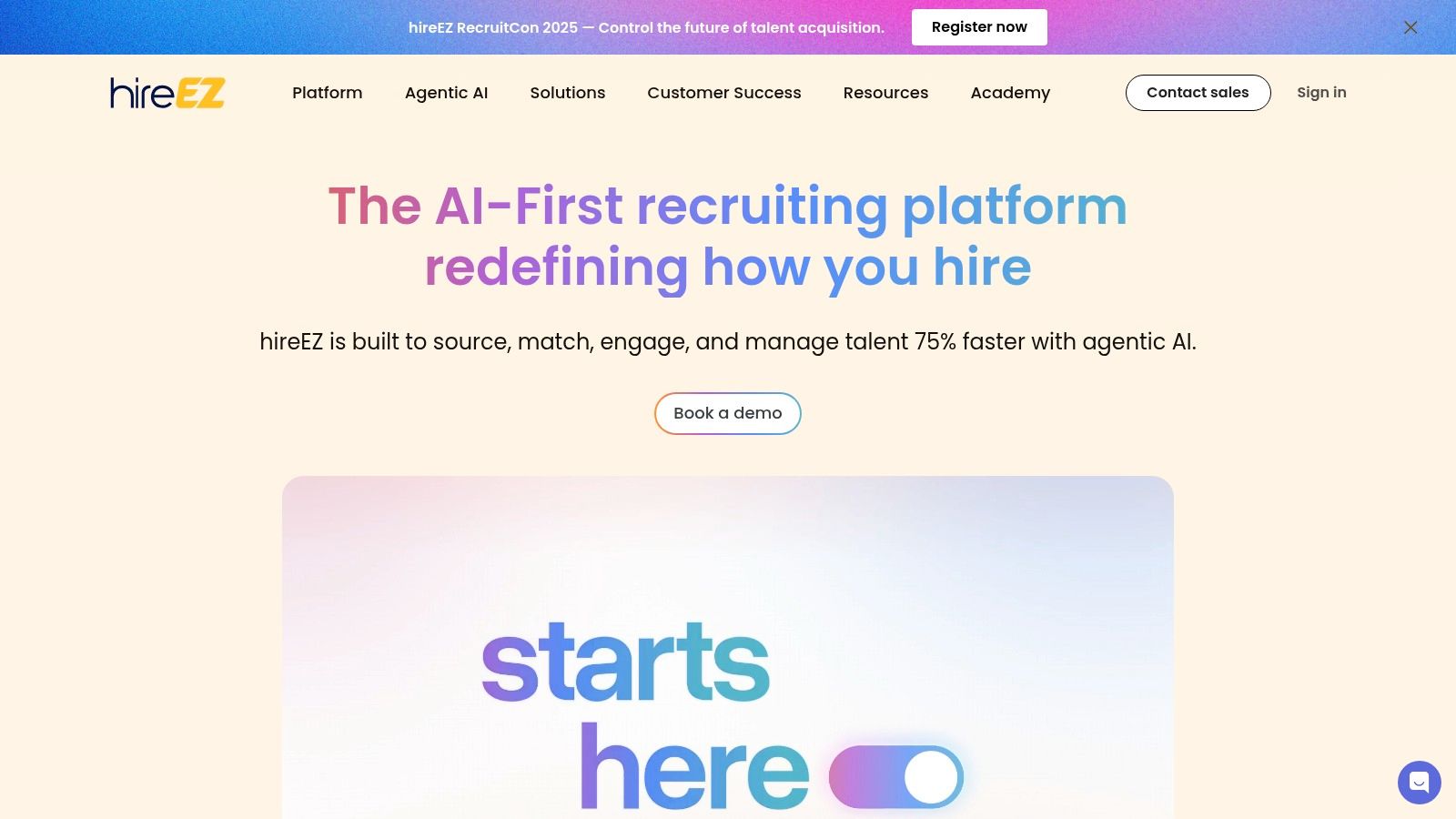
The AI sourcing engine allows recruiters to build targeted talent pipelines using specific filters like skills, experience, and diversity indicators. This helps teams build a strategic talent pool before a role even becomes available, dramatically improving recruiter efficiency and reducing the time needed to fill critical positions.
Key Features & Use Cases
hireEZ shines in its ability to centralize candidate information and automate the initial outreach process. Its powerful search capabilities and integration with major ATS platforms ensure that recruiters can manage their entire sourcing workflow from a single interface, similar to how sales teams use AI lead generation software to manage prospects.
- Use Case: A tech company needs to hire a senior software engineer with a rare skill set. Using hireEZ, a recruiter can search across platforms like GitHub, LinkedIn, and Stack Overflow, identify top candidates, find their verified contact information, and launch an automated, multi-step email campaign to initiate contact.
- Unique Offering: The platform provides valuable market insights, showing talent supply and demand, salary benchmarks, and competitor hiring trends. This data empowers recruiters to have more strategic conversations with hiring managers.
Implementation Tip: Integrate hireEZ with your ATS from day one to avoid data silos. Create and save search templates for your most common roles to standardize the sourcing process across your team and onboard new recruiters faster.
Pricing and Limitations
hireEZ’s pricing is tiered and typically requires a custom quote, positioning it for serious recruiting teams rather than individual or casual users. This pricing structure can be a barrier for smaller businesses or startups with limited HR budgets.
| Pros | Cons |
|---|---|
| Expansive candidate database from 45+ sources | Can be a significant investment for small businesses |
| Powerful AI sourcing and search filters | Has a learning curve to master all features |
| Automates and personalizes outreach campaigns | Requires proactive effort to see the best results |
While hireEZ boosts sourcing capabilities, its effectiveness depends on the recruiter's ability to craft compelling outreach. The platform provides the tools, but the human element of engagement remains critical for success.
Website: https://www.hireez.com
4. Eightfold AI
Eightfold AI positions itself as a comprehensive Talent Intelligence Platform, using deep learning AI to manage the entire talent lifecycle. It goes beyond simple recruitment by creating a unified data profile for every candidate and employee, analyzing skills, experience, and potential. This makes it one of the best AI tools for recruitment for organizations focused on strategic workforce planning and internal mobility.
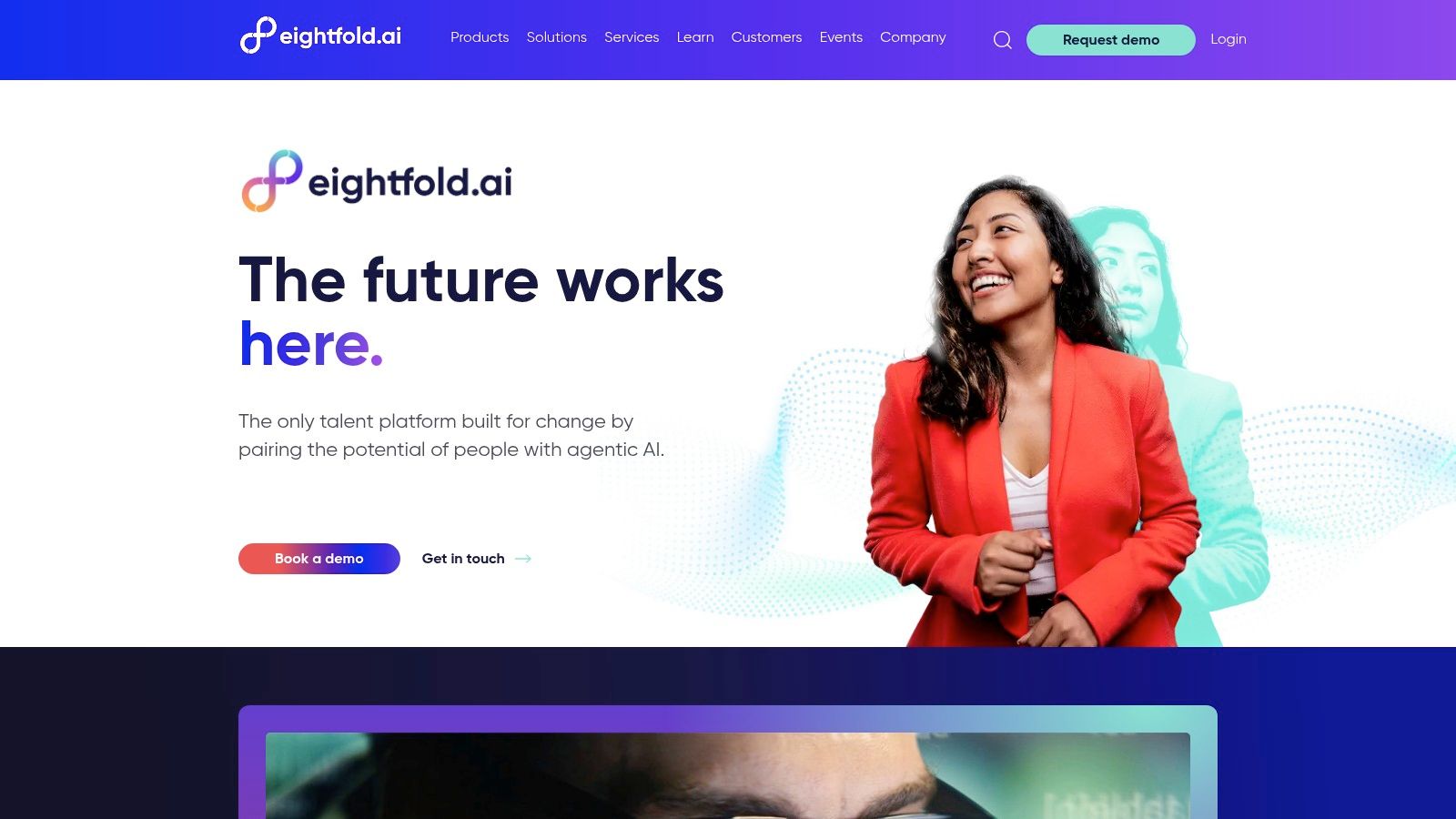
The platform’s AI engine matches individuals to opportunities, whether they are external applicants or current employees seeking growth. It helps uncover hidden talent, reskill the workforce, and build diverse teams by focusing on capabilities rather than just keywords on a resume.
Key Features & Use Cases
Eightfold AI’s strength lies in its ability to provide actionable insights across the talent ecosystem. It integrates with major Applicant Tracking Systems (ATS) and Human Resource Information Systems (HRIS), enriching existing data to drive smarter talent decisions.
- Use Case: A global technology firm wants to improve employee retention and fill more senior roles internally. Using Eightfold’s Talent Marketplace, the company can map current employee skills to future needs, identify skill gaps, and recommend personalized learning paths, while also surfacing internal candidates for open requisitions before looking externally.
- Unique Offering: The platform’s “talent calibration” feature allows managers to review and compare talent side-by-side based on objective, AI-driven insights, helping to remove unconscious bias from promotion and succession planning decisions.
Implementation Tip: Begin by integrating Eightfold with your primary ATS to build a unified talent data foundation. Focus on a specific initiative, such as improving diversity in a key department or boosting internal hire rates, to measure ROI clearly before a full-scale rollout.
Pricing and Limitations
Eightfold AI's pricing is designed for enterprise-level organizations and requires a custom quote, making it a significant investment. The platform's complexity and comprehensive nature mean it is not a plug-and-play solution.
| Pros | Cons |
|---|---|
| Provides deep, actionable talent insights | Custom pricing can be a high investment |
| Actively supports diversity and inclusion initiatives | Complexity may require extensive training for full adoption |
| Unifies external recruiting and internal mobility | Less suited for small businesses with simple hiring needs |
The platform's sophisticated features require commitment to training and change management to realize its full potential. Organizations must be prepared to invest time in configuring the system to align with their specific talent strategy and goals.
Website: https://eightfold.ai
5. Pymetrics
Pymetrics champions a new approach to talent acquisition, using gamified behavioral assessments and audited AI to predict a candidate's potential. Instead of relying on a resume, the platform evaluates an individual's inherent cognitive and emotional attributes, making it one of the best AI tools for recruitment focused on potential over pedigree. The core of Pymetrics is a series of engaging online games that measure traits like memory, risk tolerance, and altruism.
This data is then used to build a soft skills profile for each candidate, which the platform’s AI matches against the profiles of a company's top performers. This methodology helps identify candidates who are a strong behavioral fit for a role, while simultaneously working to mitigate unconscious bias that often creeps into traditional screening processes.
Key Features & Use Cases
Pymetrics is fundamentally designed to broaden the talent pool and promote diversity by focusing on objective, behavioral data. Its AI is ethically audited to ensure it does not create adverse impact against protected groups, a key differentiator in the market.
- Use Case: A financial services firm wants to improve diversity in its analyst roles, which traditionally favor candidates from specific universities. Using Pymetrics, they assess all applicants based on core competencies like problem-solving and attention to detail, discovering high-potential candidates from non-traditional backgrounds who would have been overlooked by resume screens.
- Unique Offering: The platform provides every candidate, regardless of the hiring outcome, with a personalized soft skills report. This positive feedback loop enhances the candidate experience and strengthens the employer's brand.
Implementation Tip: Define your ideal employee profile by having your current top performers complete the Pymetrics games first. This creates a benchmark for the AI to match against. Communicate clearly to candidates why you are using a gamified assessment to ensure buy-in and reduce applicant drop-off.
Pricing and Limitations
Pymetrics is designed for mid-to-large enterprises, and its pricing is provided through a custom quote based on company size and hiring volume. It is generally not suitable for small businesses or startups with limited hiring needs.
| Pros | Cons |
|---|---|
| Audited AI significantly reduces hiring bias | Success depends on candidate willingness to play games |
| Enhances candidate experience with personalized feedback | Less focused on hard skills or technical qualifications |
| Data-driven insights on role-specific competencies | Implementation requires buy-in and benchmarking from existing teams |
While a powerful tool for improving fairness, Pymetrics primarily assesses soft skills and potential. It should be used as part of a holistic hiring process that also includes methods for evaluating technical expertise and role-specific knowledge.
Website: https://www.pymetrics.com
6. Lever
Lever merges a robust Applicant Tracking System (ATS) with AI-powered enhancements, creating a unified platform for managing the entire talent lifecycle. It is recognized as one of the best AI tools for recruitment because it focuses on nurturing candidate relationships and fostering team collaboration. The platform's AI automates sourcing and rediscovery, scanning your existing talent database to surface past applicants who are a great fit for new, open roles.
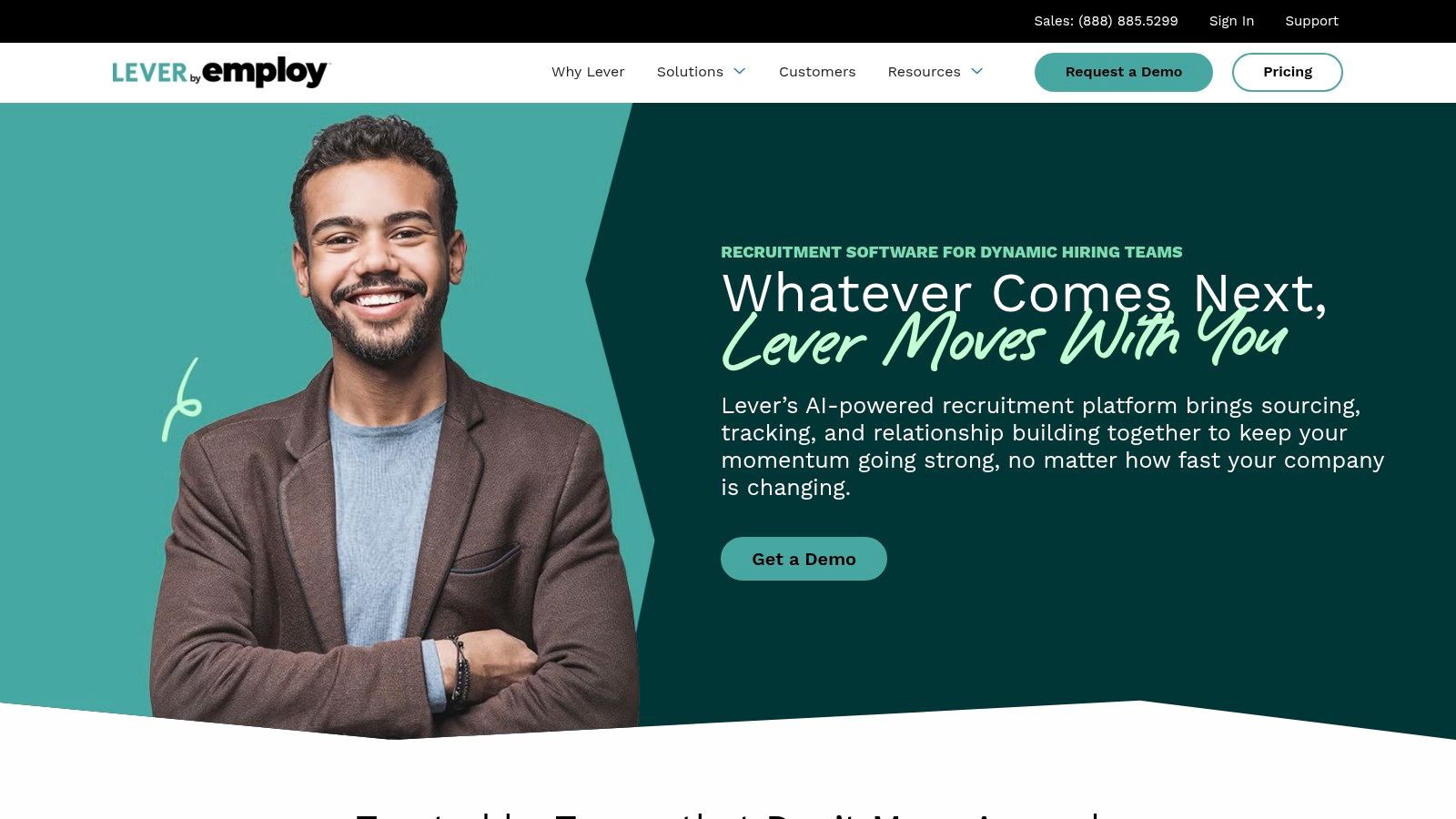
This proactive approach helps recruiters build and maintain a warm talent pipeline, reducing dependency on external job boards and active sourcing efforts. Lever’s emphasis on a collaborative interface ensures that hiring managers, interviewers, and recruiters can all communicate and provide feedback within a single system, streamlining decision-making.
Key Features & Use Cases
Lever’s strength lies in its holistic view of the candidate journey, from initial contact to hire. The platform offers powerful analytics that provide deep insights into pipeline health, diversity metrics, and team performance, enabling data-driven strategy adjustments.
- Use Case: A fast-growing tech company needs to fill multiple roles quickly without losing quality. Using Lever’s AI, the recruitment team can instantly resurface silver-medalist candidates from previous searches, re-engaging them for new positions and cutting down the time-to-fill significantly.
- Unique Offering: The platform’s native Nurture feature allows recruiters to create automated, personalized email campaigns to keep potential candidates engaged over time, building a strong employer brand.
Implementation Tip: Integrate Lever with your team's email and calendar (like G Suite or Office 365) from day one. This makes scheduling interviews and tracking communication seamless. Use the tagging system to categorize candidates by skill, location, and interest for easier rediscovery later.
Pricing and Limitations
Lever offers tiered pricing plans, typically starting with a "LeverTRM for Small Business" package, with custom quotes for larger enterprise needs. This can make it a significant investment for very small startups.
| Pros | Cons |
|---|---|
| All-in-one ATS and CRM functionality | Pricing can be a barrier for small businesses |
| Excellent for collaborative hiring and communication | Advanced analytics and reporting features may require some training to master |
| Strong focus on candidate relationship management | Some users find the UI can be less intuitive for complex workflows |
While Lever excels at nurturing and rediscovering talent, teams should ensure they have a solid data privacy policy in place, as the system centralizes a vast amount of candidate information.
Website: https://www.lever.co
7. SeekOut
SeekOut is an AI-powered sourcing and talent intelligence platform built to help recruitment teams find, engage, and hire specialized and diverse talent. It stands out as one of the best AI tools for recruitment by focusing on proactive sourcing, providing deep insights into candidate pools and helping companies build more inclusive teams. The platform aggregates data from hundreds of sources, including public profiles, GitHub, and academic papers, to create comprehensive candidate profiles.
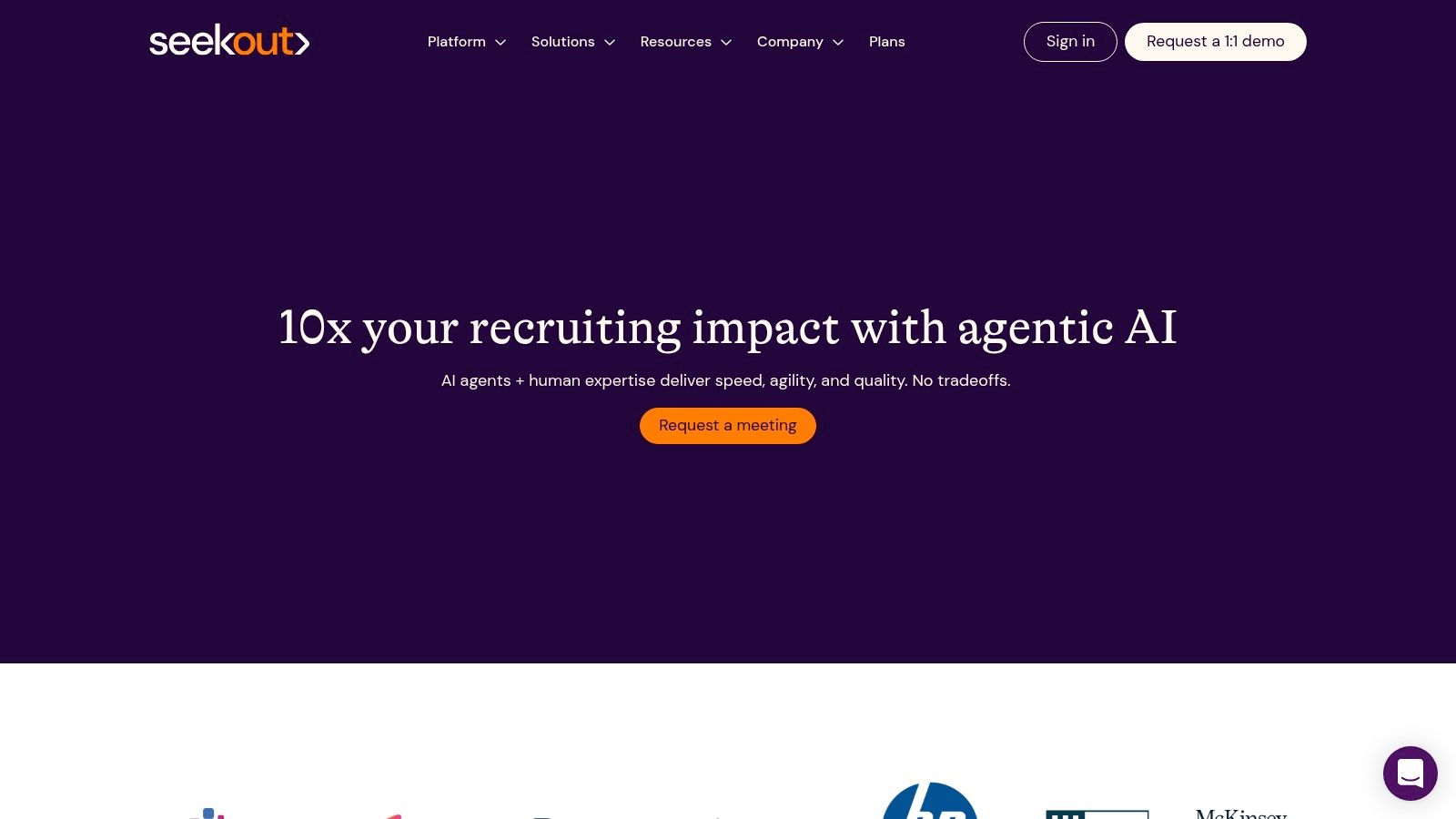
The AI engine allows recruiters to go beyond simple keyword searches, using advanced filters and "power filters" to identify candidates with specific skills, backgrounds, or experiences. This is particularly effective for finding talent in niche tech fields or for roles requiring a unique combination of expertise.
Key Features & Use Cases
SeekOut's primary strength lies in its expansive talent pool and powerful search capabilities, which include AI-powered search recommendations and diversity filters. It integrates smoothly with major ATS and CRM systems, allowing sourcers to export candidate data directly into their existing workflows.
- Use Case: A tech company needs to hire a machine learning engineer with experience in natural language processing and a background in the healthcare industry. Using SeekOut, a recruiter can combine these specific criteria to search across millions of profiles, instantly identifying a shortlist of highly qualified, hard-to-find candidates.
- Unique Offering: The platform's diversity and inclusion tools are a key differentiator. Recruiters can use dedicated filters to find candidates from underrepresented groups, helping organizations meet their diversity hiring goals with actionable data.
Implementation Tip: Leverage SeekOut's "Talent Insights" to analyze the market before starting a search. Understand the geographic distribution of specific skills, the top companies employing this talent, and diversity benchmarks to set realistic expectations and craft a targeted outreach strategy.
Pricing and Limitations
SeekOut's pricing is tailored for enterprise and high-growth companies and requires a custom quote, making it less suitable for small businesses or individual recruiters. While powerful, the sheer volume of filters and data can present a learning curve for new users.
| Pros | Cons |
|---|---|
| Exceptional at finding passive, hard-to-reach talent | Pricing can be a barrier for smaller businesses |
| Powerful features to support diversity sourcing | The extensive features can have a steep learning curve |
| Provides rich, comprehensive candidate profiles | Focus is primarily on sourcing, not full-cycle recruitment |
While SeekOut excels at the top of the funnel, it is a specialized sourcing tool. Teams will need to integrate it with other platforms for functions like interview scheduling, assessments, and onboarding.
Website: https://www.seekout.com
8. Fetcher
Fetcher operates as a full-service sourcing platform, blending AI-powered candidate discovery with a human-in-the-loop approach for quality control. It automates the repetitive top-of-funnel tasks, such as searching across platforms like LinkedIn and GitHub and crafting personalized outreach emails. This hybrid model makes it one of the best AI tools for recruitment for teams that want automation without sacrificing a personalized touch.
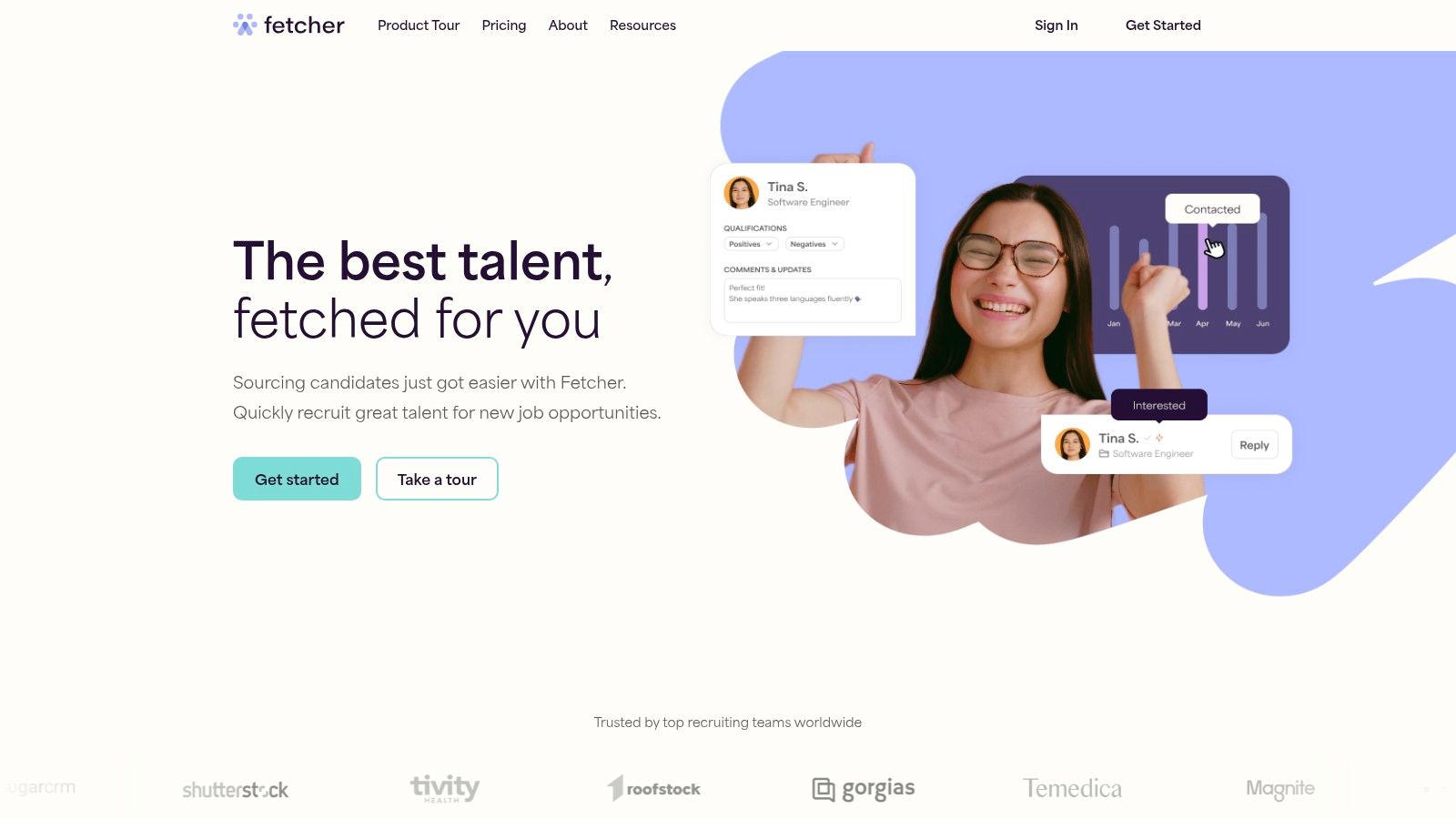
The platform delivers a curated list of qualified, interested candidates directly to a recruiter's inbox. The AI handles the initial search and outreach, while human researchers vet the profiles to ensure they align with the role's specific nuances and the company's culture, significantly boosting response rates and candidate quality.
Key Features & Use Cases
Fetcher stands out by automating outreach sequences and tracking engagement, freeing recruiters to focus on building relationships with interested candidates. Its seamless integration with popular ATS, email, and calendar systems ensures it fits smoothly into existing workflows without requiring a complete process overhaul.
- Use Case: A scaling tech startup needs to hire several senior engineers but lacks a dedicated sourcing team. Using Fetcher, the hiring manager can set the criteria, and the platform automatically sources profiles and initiates personalized email campaigns, delivering a steady pipeline of vetted candidates ready for an initial call.
- Unique Offering: The combination of AI sourcing with human curation ensures a higher signal-to-noise ratio than purely automated tools, while its built-in analytics help teams track pipeline health and optimize diversity sourcing efforts.
Implementation Tip: Be highly specific in your initial role calibration with the Fetcher team. Provide detailed examples of ideal profiles and "must-have" versus "nice-to-have" skills to train the AI and human researchers effectively from the start.
Pricing and Limitations
Fetcher's pricing is customized and typically requires a demo and quote, positioning it for businesses ready to invest in scaling their talent acquisition function. This model may be less suitable for very small companies with minimal or sporadic hiring needs.
| Pros | Cons |
|---|---|
| Drastically reduces time spent on sourcing | Custom pricing can be a barrier for smaller teams |
| Human-in-the-loop ensures high-quality matches | Less control over the fine-tuning of search strings |
| Built-in analytics for diversity and outreach | Dependent on integration for a complete workflow |
While Fetcher streamlines top-of-funnel activities, teams must maintain strong internal processes for interviewing and closing candidates. It is a sourcing engine, not an end-to-end recruitment platform.
Website: https://www.fetcher.ai
9. Textio
Textio is an augmented writing platform that uses AI to analyze and improve the language in job descriptions, recruiting emails, and other talent communications. It's one of the best AI tools for recruitment focused on inclusive language, helping teams attract a more diverse and qualified applicant pool by removing unconscious bias from their writing. The platform provides real-time guidance and scores your content based on its projected appeal to different demographics.
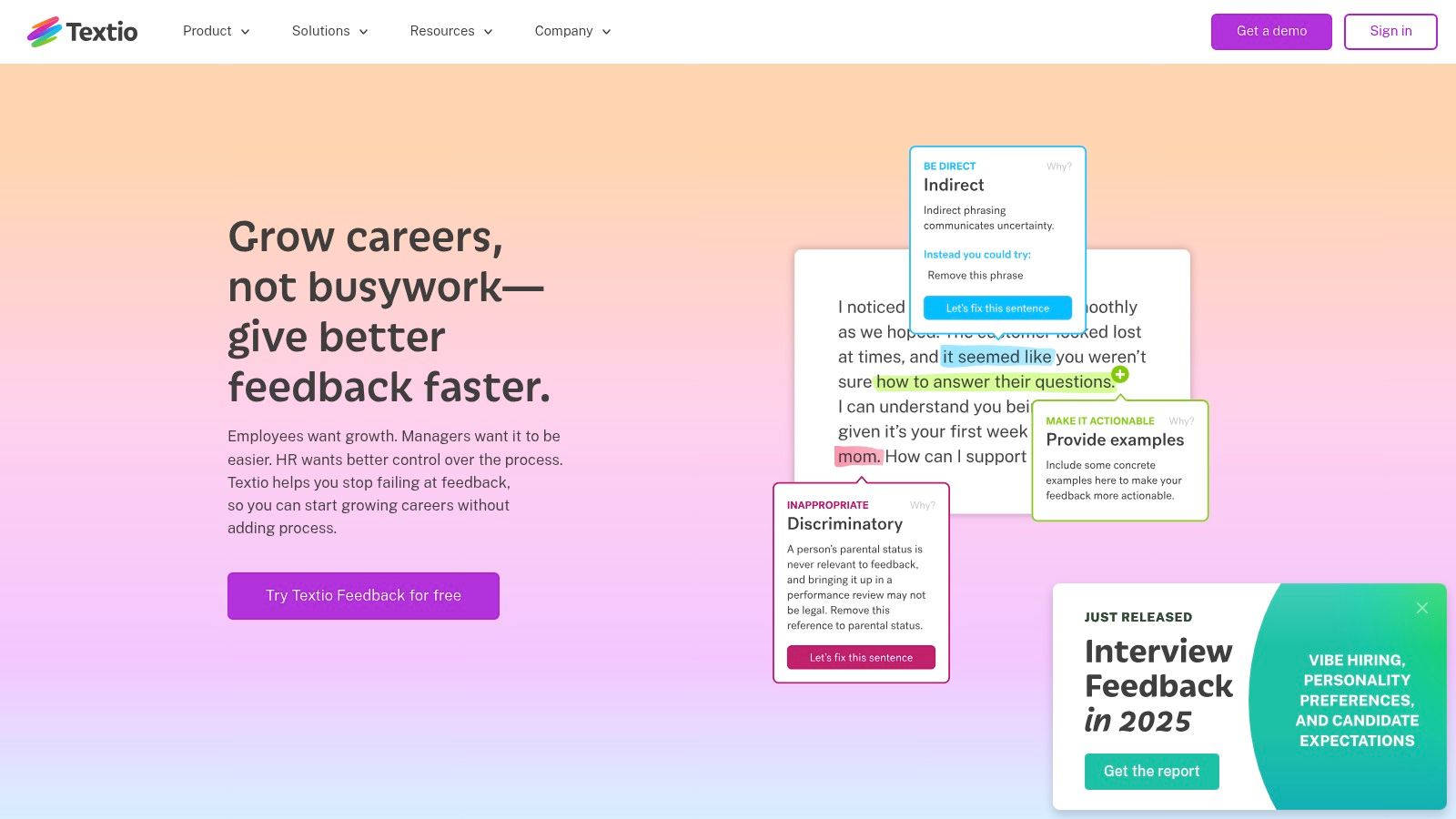
By flagging gendered language, corporate jargon, and exclusionary phrases, Textio helps recruiters craft messages that resonate with a broader audience. The core principle is that the words you choose directly impact who applies. Platforms like Textio leverage AI for tasks such as AI-powered job description analysis to enhance clarity and diversity in listings, ultimately improving hiring outcomes.
Key Features & Use Cases
Textio's strength lies in its ability to provide data-backed linguistic suggestions that go beyond simple grammar checks. It integrates directly into platforms like Greenhouse, Workday, LinkedIn, and Gmail, making it easy for teams to use it within their existing workflows.
- Use Case: A tech company struggles to attract female engineers. By running their job descriptions through Textio, the hiring team identifies and replaces male-coded words like "dominate" and "rockstar" with more inclusive alternatives like "succeed" and "pioneer," leading to a measurable increase in applications from women.
- Unique Offering: The platform includes a "Tone Meter" that visualizes the overall feel of your writing, helping you strike the right balance between professional and engaging.
Implementation Tip: Roll out Textio to the entire talent acquisition team and establish a minimum "Textio Score" for all external-facing job posts. Use its analytics dashboard to track which teams are adopting the tool and correlate score improvements with applicant diversity data.
Pricing and Limitations
Textio's pricing is designed for business use and requires a custom quote, making it less accessible for individuals or very small businesses. Its focus is entirely on text-based content and does not assist with other parts of the recruitment process like screening or interviewing.
| Pros | Cons |
|---|---|
| Promotes inclusive language and diversity | Pricing may be prohibitive for small businesses |
| Integrates with major ATS and email clients | Focus is limited to text-based content only |
| Provides actionable, data-driven insights | Effectiveness depends on team adoption and consistent use |
While highly effective for improving job posts and outreach, Textio is a specialized tool. It works best when combined with other recruitment platforms to address the full hiring lifecycle.
Website: https://textio.com
10. Workable
Workable is a comprehensive human resources software solution designed primarily for small and medium businesses. It integrates powerful AI to enhance the talent acquisition process, making it one of the best AI tools for recruitment for teams that need an all-in-one platform. Its AI-powered features focus on sourcing candidates more effectively and simplifying hiring decisions through smart recommendations.
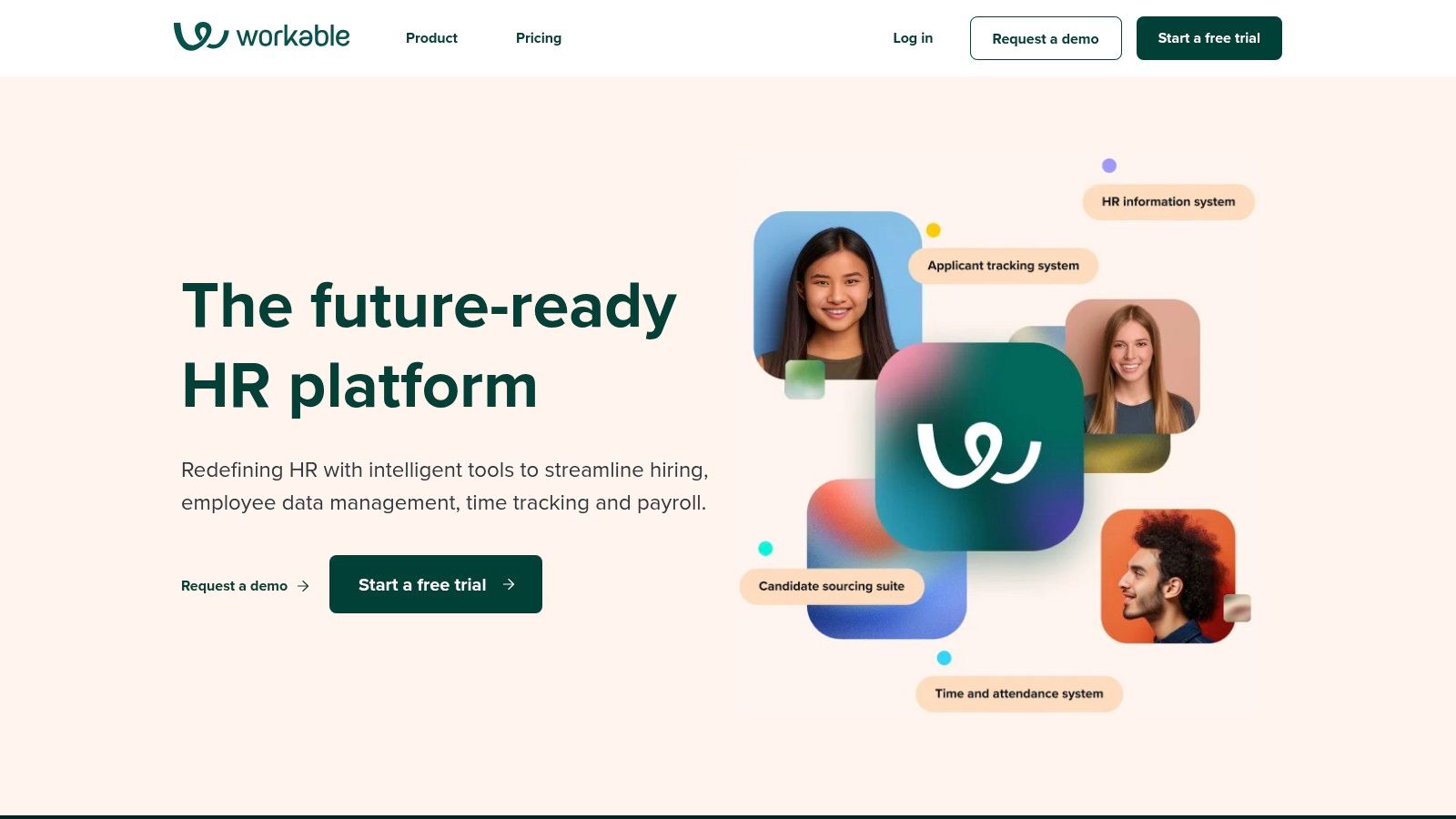
The platform’s AI scans a vast pool of passive candidates and recommends the best matches for your open roles, saving significant sourcing time. This is complemented by automated outreach tools and integrated compliance features, ensuring a streamlined and secure hiring workflow. Many users find Workable's approach to be a powerful example of AI workflow automation tools.
Key Features & Use Cases
Workable shines in its ability to centralize recruitment activities while embedding AI to optimize key steps. The user-friendly interface supports collaborative hiring, allowing team members to review candidates, leave feedback, and track progress together.
- Use Case: A scaling tech startup needs to hire several software developers quickly. Using Workable’s AI, the hiring manager can instantly get a list of top matching candidates from a passive talent pool, run automated email campaigns to engage them, and manage the entire interview pipeline within one system.
- Unique Offering: The “AI Recruiter” feature automatically sources and suggests candidates based on the job description, acting like an internal sourcing assistant and reducing manual search efforts on platforms like LinkedIn.
Implementation Tip: Leverage the one-click job posting to major job boards. When setting up a role, be as detailed as possible in the job description to give the AI Recruiter the best data to find highly relevant candidates for you.
Pricing and Limitations
Workable offers a transparent pricing model, starting with a “Pay as you go” plan for a single job post. Standard and Premier plans are available with monthly or annual billing, scaling with company needs.
| Pros | Cons |
|---|---|
| User-friendly and intuitive interface | Limited customization options in lower-tier plans |
| Comprehensive end-to-end recruitment features | Premium AI features may require higher-cost plans |
| Strong support for collaborative hiring | Can become expensive as hiring volume increases |
While its all-in-one nature is a major benefit, businesses with highly specific or unique hiring workflows may find the customization options slightly restrictive compared to more modular systems.
Website: https://www.workable.com
11. Manatal
Manatal is an accessible, cloud-based recruitment software that positions itself as an all-in-one solution for small to medium-sized businesses. It integrates AI into core recruiting workflows, from candidate sourcing to onboarding, making it one of the best AI tools for recruitment for teams seeking affordability and comprehensive functionality without the enterprise-level complexity. The platform uses AI to enrich candidate profiles and provide smart recommendations based on job requirements.
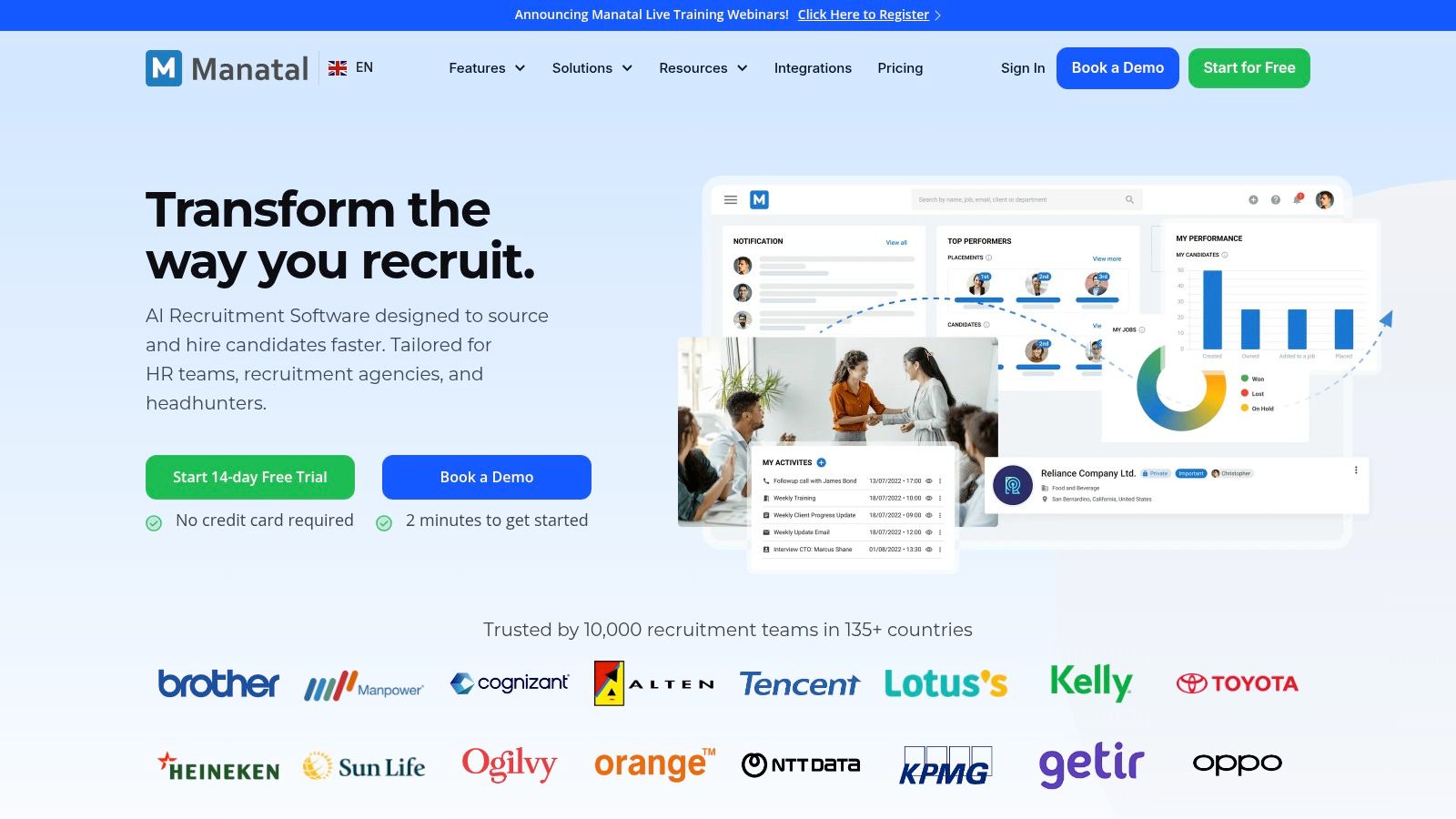
The system automatically parses resumes and social media profiles (like LinkedIn) to build complete candidate profiles, then scores and ranks them against your open roles. This AI-powered matching helps recruiters quickly identify top talent from their existing database or new applicants, saving significant time in the initial screening phase.
Key Features & Use Cases
Manatal’s strength lies in its user-friendly interface combined with a robust set of features, including a built-in CRM for candidate relationship management. It helps teams manage the entire pipeline from a single dashboard, enhancing collaboration and visibility.
- Use Case: A growing startup needs to hire for multiple roles but lacks a dedicated, large HR team. Using Manatal, they can post to multiple job boards at once, have the AI automatically screen and rank incoming applicants, and use the built-in CRM to nurture promising candidates for future openings.
- Unique Offering: Its AI-powered sourcing extension for browsers allows recruiters to instantly add candidates from platforms like LinkedIn to their talent pool, with the AI automatically enriching the profile with publicly available data.
Implementation Tip: Leverage the platform’s custom pipeline features from day one. Define clear stages for your recruitment process (e.g., Sourced, Screened, Interview 1, Offer) within Manatal to ensure your team follows a standardized workflow and you can accurately track conversion rates.
Pricing and Limitations
Manatal offers transparent, tiered pricing that is highly competitive, with plans starting from $15 per user/month. This makes it a great option for SMBs and recruitment agencies. A 14-day free trial is available without a credit card.
| Pros | Cons |
|---|---|
| Very affordable and transparent pricing | Lacks some advanced features for large enterprises |
| User-friendly interface with minimal learning curve | Integration options may be less extensive than premium ATS |
| Comprehensive ATS and recruitment CRM features | Reporting capabilities are solid but may not be as deep as enterprise tools |
While excellent for its target market, large enterprises with complex global hiring needs might find its feature set and integration capabilities more limited compared to platforms like HireVue or Greenhouse.
Website: https://www.manatal.com
12. Humanly
Humanly leverages conversational AI to automate and enhance the critical first steps of the hiring process. It functions as an intelligent chatbot that engages candidates in real-time conversations, screening them for qualifications and fit. As one of the best AI tools for recruitment focused on candidate experience, it ensures every applicant receives a prompt and personalized interaction, 24/7.
The platform’s AI goes beyond simple keyword matching, analyzing conversational context to assess a candidate's skills, experience, and motivation. This initial screening data is then used to automatically advance qualified individuals to the next stage, often by seamlessly scheduling an interview with a human recruiter directly within the chat.
Key Features & Use Cases
Humanly excels at scaling top-of-funnel activities without sacrificing candidate engagement. Its deep integrations with major ATS platforms like Greenhouse and Lever ensure that all conversations and data points are captured and synced with the candidate's official record.
- Use Case: A fast-growing tech company receives hundreds of applications for its engineering roles. They use Humanly's AI chatbot on their careers page to instantly engage every applicant, ask role-specific screening questions, and automatically schedule a technical phone screen for those who meet the baseline criteria.
- Unique Offering: Humanly’s AI can conduct reference checks via chat or email, automating a traditionally manual and time-consuming task for recruiters.
Implementation Tip: Customize your chatbot's screening questions to reflect not only the role's hard skills but also key cultural values. Train your recruiting team to review the conversation transcripts for qualitative insights, not just the pass/fail screening results.
Pricing and Limitations
Humanly’s pricing is based on a custom quote, tailored to the organization's size, hiring volume, and specific feature needs. This makes it a better fit for mid-market and enterprise clients rather than small businesses.
| Pros | Cons |
|---|---|
| Significantly reduces recruiter time on screening | Custom pricing may be a barrier for smaller teams |
| Improves candidate engagement and experience | Primarily focused on top-of-funnel screening |
| Provides analytics on candidate conversations | Effectiveness is highly dependent on initial setup and question design |
While excellent for initial engagement and qualification, its utility is concentrated at the beginning of the recruitment lifecycle. Teams will still rely on other tools and human judgment for later-stage interviews and final decision-making.
Website: https://www.humanly.io
Top 12 AI Recruitment Tools Feature Comparison
| Product | Core Features | User Experience & Quality | Value Proposition | Target Audience | Price Points / Notes |
|---|---|---|---|---|---|
| HireVue | AI video interviews, automated assessment, ATS integration | Reduces time-to-hire, detailed analytics | Streamlines hiring process, enhances engagement | Mid-sized to large businesses | Higher cost, potential bias concerns |
| Paradox | Conversational AI assistant, scheduling, ATS integration | High candidate satisfaction, boosts recruiter productivity | Automates repetitive tasks, accelerates hiring | High-volume hiring teams | Custom pricing, limited customization |
| hireEZ | AI candidate sourcing, outreach templates, ATS integration | Extensive candidate database, market insights | Improves recruiter efficiency | Recruiting teams, enterprises | Pricing may be high for small biz |
| Eightfold AI | Talent matching, predictive analytics, ATS & HRIS integration | Supports diversity, actionable insights | Enhances inclusion, internal mobility | Large organizations | Custom pricing, complex training |
| Pymetrics | Behavioral assessments, bias reduction | Fair hiring practices, gamified, data-driven | Reduces bias, improves candidate fit | Companies focused on fair hiring | Participation in games required |
| Lever | AI sourcing, robust analytics, ATS integration | Collaborative hiring, data-driven decisions | Unified platform for recruitment | Talent teams, enterprises | Pricing high for small businesses |
| SeekOut | Advanced search, diversity tools, ATS & CRM integration | Finds hard-to-reach talent, rich profiles | Supports diversity and inclusion | Companies seeking diverse talent | Pricing high for small businesses |
| Fetcher | AI sourcing, automated outreach, ATS/email/calendar integration | Improves recruiter productivity, analytics | Combines AI and human expertise | Mid to large recruiting teams | Custom pricing, requires integration |
| Textio | Bias detection, language optimization, ATS/email integration | Inclusive language, improves branding | Enhances recruitment messaging | HR and talent acquisition | Pricing high, text-based only |
| Workable | AI recommendations, automated outreach, compliance tools | User-friendly, collaborative hiring | Simplifies recruitment for SMBs | Small to medium businesses | Premium features cost extra |
| Manatal | AI recommendations, built-in CRM, user-friendly | Affordable, comprehensive features | Streamlined recruitment | Small to medium businesses | Affordable, limited enterprise features |
| Humanly | Chat-based screening, interview scheduling, ATS integration | Saves time, good candidate engagement | Automates initial screening | Recruiting teams | Custom pricing, screening only |
The Future is Now: Building a Strategic Talent Function with AI
We've explored a comprehensive landscape of the best AI tools for recruitment, from comprehensive talent intelligence platforms like Eightfold AI and SeekOut to specialized solutions like Textio for inclusive language and Pymetrics for objective behavioral assessments. The journey through these twelve powerful platforms reveals a clear, undeniable truth: AI is no longer a futuristic concept in hiring but a present-day strategic imperative. The era of purely manual, intuition-driven recruitment is fading, replaced by a more intelligent, data-informed, and human-centric approach.
The core takeaway is that these tools are not about replacing recruiters. Instead, they are about augmenting their capabilities, freeing them from the high-volume, repetitive tasks that cause burnout and allowing them to focus on what truly matters: building meaningful relationships with candidates and making strategic, high-impact hiring decisions. Platforms like Paradox and Humanly automate initial engagement, while tools like hireEZ and Fetcher build robust talent pipelines, giving your team the leverage to operate at a higher, more strategic level.
From Tactical Tool to Strategic Partner: Making Your Choice
Selecting the right AI recruitment tool isn't about finding a single "best" solution, but rather finding the right fit for your organization's unique challenges, scale, and maturity. Your decision-making process should be a thoughtful evaluation, not a hasty adoption of the latest trend.
To guide your selection, consider these key questions:
- What is our primary bottleneck? Are you struggling with sourcing passive candidates (consider SeekOut or hireEZ), managing high-volume applications (look at Paradox or Manatal), or conducting effective initial screenings (explore HireVue or Humanly)? Pinpoint your biggest pain point first.
- What is our company size and hiring volume? A startup's needs will differ vastly from a global enterprise. Solutions like Workable or Manatal offer excellent value for SMBs, while platforms like Eightfold AI are built for the complexity of large, multinational corporations.
- How important is candidate experience? Tools like Paradox, with its conversational AI assistant Olivia, prioritize a seamless and engaging candidate journey from the very first touchpoint. Pymetrics offers a gamified, bias-free assessment that candidates often prefer over traditional tests.
- What does our existing tech stack look like? Seamless integration is critical. Before committing, verify that your chosen tool integrates smoothly with your current ATS (like Lever or Workable) and other HR systems to avoid creating data silos.
Implementation: The Human Element of AI Success
Acquiring a powerful tool is only the first step. Successful implementation hinges on a strategic rollout and a commitment to change management. Don't simply hand the software to your team and expect magic. To truly build a strategic talent function, understanding the broader landscape of automation in talent acquisition is essential.
Focus on these pillars for a smooth transition:
- Champion Clear Use Cases: Define exactly how the tool will be used. Will it automate screening for specific roles? Will it be the primary engine for diversity sourcing? Clear directives prevent confusion and ensure consistent adoption.
- Invest in Training: Your team needs to understand not just how to use the tool, but why they are using it. Frame it as a way to enhance their skills and reduce administrative burdens, not as a replacement for their expertise.
- Establish Success Metrics: How will you measure ROI? Define key performance indicators (KPIs) upfront. This could be a reduction in time-to-fill, an increase in candidate pipeline diversity, a higher offer acceptance rate, or improved quality of hire.
- Iterate and Optimize: The AI landscape evolves rapidly. Regularly review your tool's performance, gather feedback from your team, and stay informed about new features to ensure you are maximizing its value.
The future of recruitment is a powerful partnership between human intuition and artificial intelligence. By thoughtfully selecting and implementing the right AI tools, you can transform your talent acquisition function from a reactive cost center into a proactive, strategic driver of business growth.
Ready to connect your new AI recruitment tools with the rest of your tech stack? MakeAutomation offers a powerful, no-code platform to integrate your favorite apps and automate complex workflows. Bridge the gap between your ATS, CRM, and communication tools to create a truly seamless, end-to-end recruitment process with MakeAutomation.



